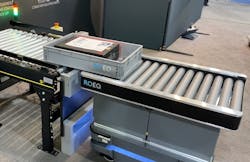Robot Cart Conveyor System Doubles Capacity
The application of robotics to conveyance technologies is picking up speed to help manufacturing and packaging operations become more flexible when adapting to changing customer demands. Evidence of the growing combination of conveyor and robotic systems was on display at the RoEq booth at Modex 2022 in Atlanta.
At the event, RoEq highlighted the release of its TMS-C500 Ext and S-Cart500 Ext, which enable users of the MiR250 autonomous mobile robot (AMR) to have the robot to carry up to a 500 kg payload (1,102 lbs.), which doubles the 250 kg payload of the MiR250 (as indicated by its name). The design of the TMS-C500 Ext top module also extends the size of cargo capable of being carried—up to 1.2 meters (47.2 in.) in length—without affecting access to the cart’s emergency stop button.
Michael Ejstrup Hansen, managing director of RoEq, said RoEq’s standardized mobile robotic equipment is designed to be compatible with MiR AMRs, including compliance with applicable safety regulations, such as the European EN 1525:1997 and the American ANSI/ITSDF B56.5-2019 standards. Hansen noted that, like all RoEq top modules, the TMS-C500 Ext comes with RoEq Assist software that loads pre-coded missions into the MiR robot, which can then be modified in the MiR interface for quick and consistent application deployments of the AMR.
In this video, captured at Modex 2022, Jonathen Keravolias, head of sales in the Americas for RoEq, explains RoEq’s GuardCom and top roller systems. The GuardCom system uses sensors to enable communication between RoEq’s top rollers (conveyors that fit on top of AMRs) and stationary conveyors. The TR125 top roller system from RoEq is used in the demo. The aim of GuardCom is to replace the use of Wi-Fi communication between such systems that can be impacted by signal delays, causing problems in the transfer of goods from mobile robots to conveyors and vice versa.
About the Author
David Greenfield, editor in chief
Editor in Chief

Leaders relevant to this article:
